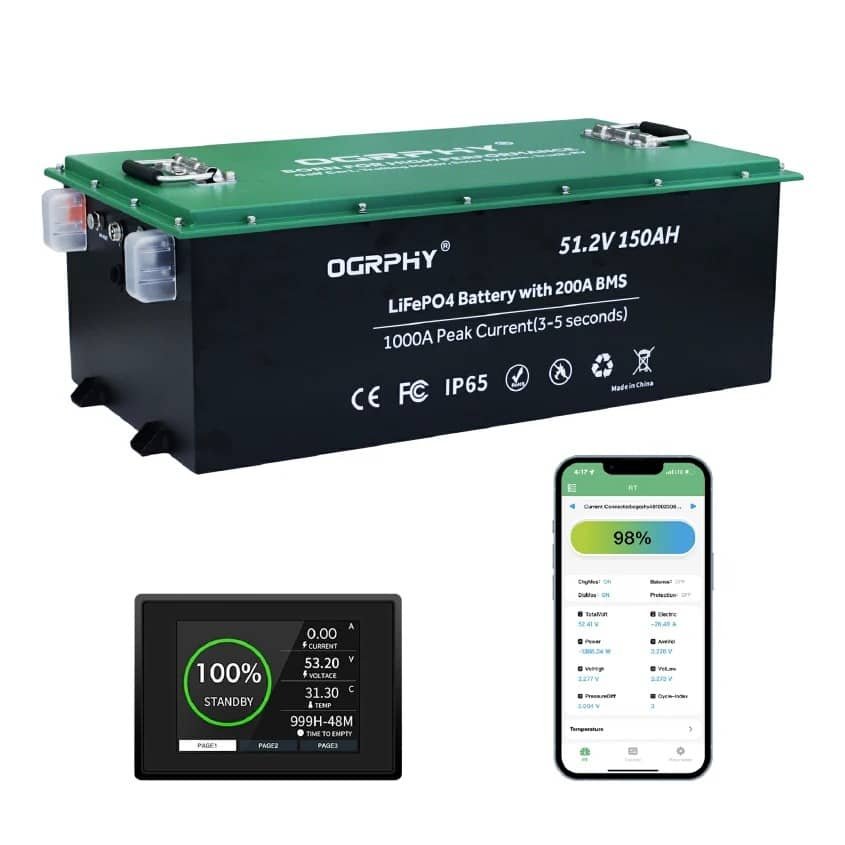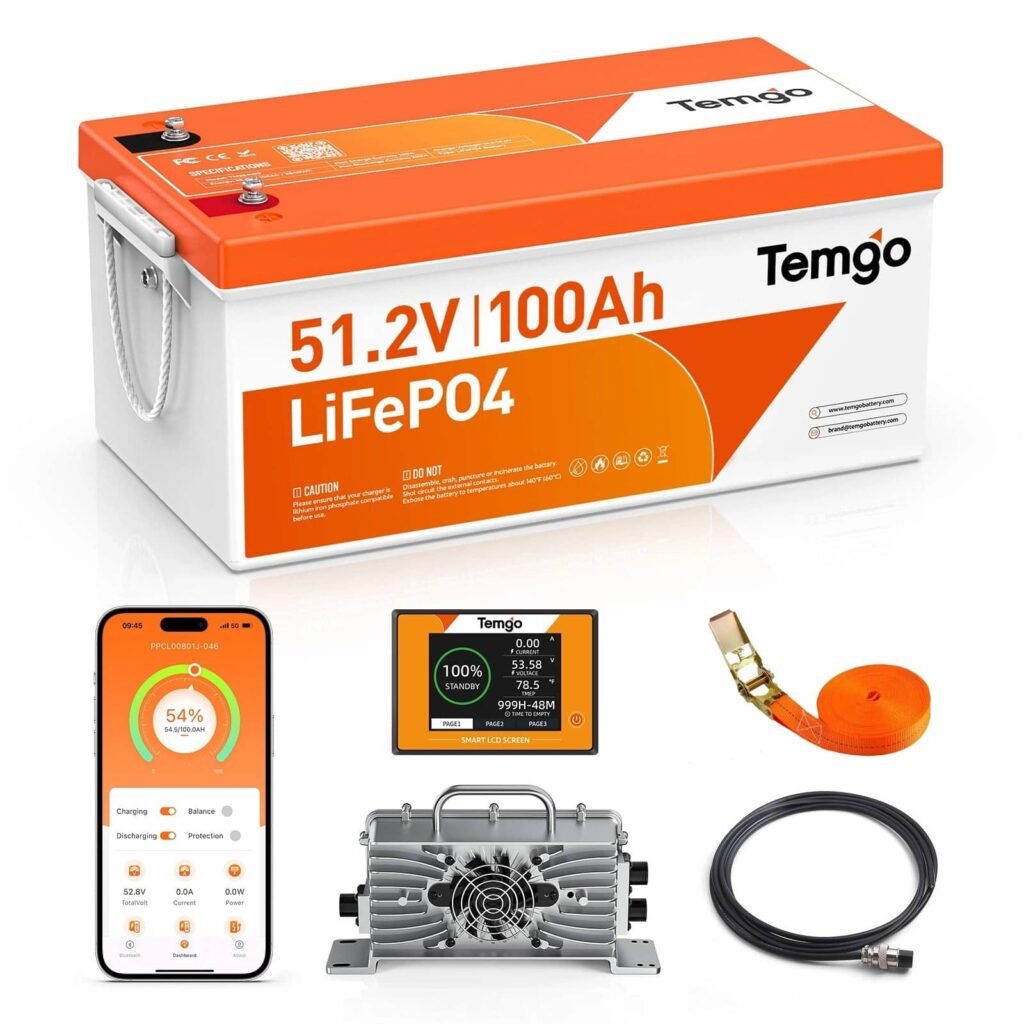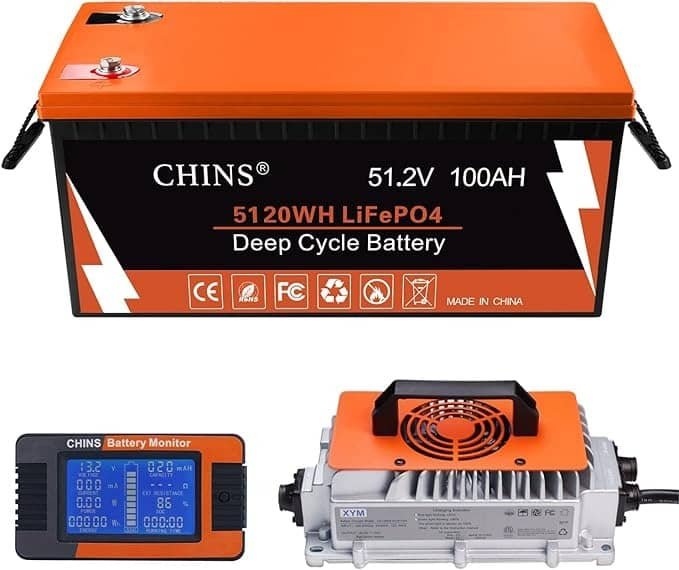Disclosure
This website is a participant in the Amazon Services LLC Associates Program,
an affiliate advertising program designed to provide a means for us to earn fees
by linking to Amazon.com and affiliated sites.
A 48V battery is considered fully charged at around 54.6 volts and fully discharged at approximately 42 volts. This voltage range is essential for understanding the battery’s state of charge (SOC), maintaining battery health, and avoiding permanent damage due to over-discharging or overcharging.
Have you ever looked at your 48V battery display and wondered what the voltage really means? You’re not alone. Whether you’re using it in an electric bike, solar power system, or golf cart, the voltage readings can be confusing if you don’t know what they represent.
Best Batteries for 48V Applications
If you’re in the market for a dependable 48V battery, not all are created equal. Below are three top-rated 48V batteries for different needs—whether you’re powering an electric bike, solar energy system, or golf cart.
OGRPHY 48V 150Ah LiFePO₄ Battery Kit
Built-in 200A BMS with mobile app, touch monitor, and 1000A peak current. Offers up to 10.24kW output and ~70-mile range. Ideal for extended golf cart use. Includes charger and is Prime Day discounted.

TEMGO 48V (51.2V) 100Ah LiFePO₄ Battery
Complete upgrade kit includes charger, LCD display, app support, and 200A BMS. Offers up to 10.24kW output and 5,000+ cycles. A perfect long-term solution for 48V golf carts with reliable performance.

CHINS 48V 100Ah LiFePO₄ Battery
Includes Bluetooth-enabled 200A BMS, 48V 18A charger, LCD monitor, and supports safe, stable output. Delivers 6000+ deep cycles and strong peak current—ideal for golf carts, RVs, and solar systems.

What Is the Normal Voltage Range for a 48V Battery?
The normal voltage range for a 48V lithium battery typically spans from 42V (empty) to 54.6V (fully charged). Understanding this range is essential for safe and efficient battery use.
Different chemistries (like LiFePO4, lead-acid, or lithium-ion) have slight variations in how they behave, but here’s a quick general guide:
General 48V Lithium-ion Battery Voltage Chart
| State of Charge | Voltage (Approx.) |
| 100% | 54.6V |
| 90% | 53.4V |
| 80% | 52.2V |
| 70% | 51.0V |
| 60% | 49.8V |
| 50% | 48.6V |
| 40% | 47.4V |
| 30% | 46.2V |
| 20% | 45.0V |
| 10% | 43.8V |
| 0% | 42.0V |
This table gives you a snapshot of your battery’s state just by looking at its voltage.
Why It Matters
- Overcharging (above 54.6V) can trigger thermal issues or shorten the battery’s lifespan.
- Over-discharging (below 42V) can cause irreversible damage, especially in lithium batteries.
Most modern systems include Battery Management Systems (BMS) that automatically cut off power before reaching these critical thresholds. Still, knowing the numbers lets you troubleshoot issues faster and prevent costly failures before they happen.
When operating a 48V system, always monitor the voltage under load and resting voltage, as active use can temporarily cause a drop that might look like the battery is lower than it actually is.
How Do You Read a 48V Battery Voltage Chart Accurately?
Reading a 48V battery voltage chart accurately means matching the voltage reading with the battery’s resting state—not while charging or under load. This helps you determine its actual state of charge (SOC).
Step-by-Step Guide to Reading It Correctly:
- Let the battery rest
After charging or discharging, wait at least 30 minutes. This allows surface charge or load dips to stabilize. - Use a calibrated multimeter or monitor
Check the voltage at the terminals using a reliable tool like the Victron BMV-712 or a Fluke multimeter. - Compare with chart values
Match the voltage reading to the SOC values in your battery’s specific voltage chart. For example:- 54.6V = 100% full
- 48.6V = 50% charge
- 42.0V = 0% charge
- Account for battery type
Lithium-ion, LiFePO4, and lead-acid batteries all have different discharge curves. Make sure you’re using a chart tailored to your battery chemistry.
Common Mistakes to Avoid
- Measuring under load: This can drop the voltage temporarily and give a false “low battery” reading.
- Ignoring battery temperature: Cold temps can affect voltage readings.
- Using a generic chart: Always refer to the manufacturer’s chart when possible.
If your system supports Bluetooth BMS, you can get real-time voltage and cell-level data directly on your phone—more accurate than manual readings and more convenient for ongoing monitoring.
What Are the Risks of Running a 48V Battery Too Low?
Running a 48V battery below its recommended cut-off voltage—typically 42V for lithium-ion—can result in permanent battery damage, reduced capacity, or complete failure.
Many users push their batteries to the edge to squeeze out more runtime, but doing so can be a costly mistake.
What Happens When Voltage Drops Too Low?
- Cell Imbalance: In lithium batteries, low voltage can cause individual cells to drop below safe limits, throwing the pack out of balance.
- Battery Degradation: Each time you deeply discharge, you accelerate wear and reduce the battery’s cycle life.
- System Shutoff: Most BMS-equipped batteries will auto-cut power before reaching critical lows—but not always fast enough to prevent stress.
- Complete Failure: In extreme cases, the battery won’t recharge, requiring a costly replacement.
Symptoms of Over-Discharge
- Voltage reads under 42V even at rest
- Battery won’t hold charge
- Reduced runtime
- Error messages on chargers or controllers
- No output despite full recharge cycle
How to Prevent Over-Discharging
- Install a low-voltage cutoff system
Ensure your BMS or inverter cuts power at or above 42V. - Use a battery monitor
Set alarms or thresholds for voltage dips. - Avoid full discharge cycles
Keeping your battery between 20–80% SOC dramatically improves long-term health.
Remember, batteries don’t “run out” like gas tanks—they degrade. Every deep discharge shortens their lifespan.
Can You Charge a 48V Battery with a Standard Charger?
No, you should not charge a 48V battery with a standard charger unless it is specifically designed for 48V systems and matches your battery’s chemistry. Using the wrong charger can damage the battery or create a safety hazard.
Why a “Standard” Charger May Not Work
Most general-purpose chargers are made for 12V or 24V systems. Using one for a 48V battery can:
- Fail to charge the battery completely (undervoltage)
- Overcharge and damage the battery (if voltage exceeds safe limit)
- Trigger the BMS to shut down the battery
- Void the battery warranty
What to Look for in a 48V Battery Charger:
- Voltage Compatibility
Ensure the charger outputs 54.6V for lithium-ion or 58.8V for lead-acid. This matches the full charge voltage. - Amp Rating
A higher amp rating charges faster, but it must be within the safe range your battery can accept—typically between 5A–20A. - Battery Chemistry Match
LiFePO4, lithium-ion, and sealed lead-acid each require different charge profiles. Never use a lithium charger on a lead-acid battery. - Built-in Protections
Look for short-circuit, overcurrent, and temperature protection features for safety.
Recommended Chargers for 48V Systems:
- NOCO Genius GX4820 – Smart charger for various chemistries
- Ebike Li-ion 48V 2A Charger – Great for e-bike and scooter batteries
- Y&H 58.8V 5A Charger – Ideal for sealed lead-acid 48V systems
Using the correct charger ensures a safe, full, and healthy charge cycle, extending your battery’s lifespan and protecting your investment.
How Long Does a Fully Charged 48V Battery Last?
A fully charged 48V battery can last anywhere from 1 hour to over 12 hours, depending on its amp-hour (Ah) capacity, the load it’s powering, and its overall efficiency.
To calculate the runtime accurately, you need to understand the relationship between voltage, capacity (Ah), and load (watts).
Formula to Estimate Runtime:
Battery Watt-Hours (Wh) = Voltage (V) × Capacity (Ah)
Estimated Runtime (hrs) = Battery Wh ÷ Load Power (W)
Example:
- 48V 20Ah battery = 960Wh
- If your device uses 200W:
- 960Wh ÷ 200W = 4.8 hours of run time
Common 48V Battery Sizes and Their Runtimes
| Battery Size | Watt-Hours (Wh) | Typical Runtime @ 250W |
| 48V 10Ah | 480 Wh | ~1.9 hours |
| 48V 15Ah | 720 Wh | ~2.9 hours |
| 48V 20Ah | 960 Wh | ~3.8 hours |
| 48V 50Ah (Large) | 2400 Wh | ~9.6 hours |
Note: These are ideal estimates. Real-world usage includes losses from the inverter, wiring, and inefficiencies in the motor or device.
Factors That Affect Runtime
- Load Type: High-drain tools and motors drain faster.
- Terrain (e-bikes/vehicles): Hills and acceleration reduce runtime.
- Battery Health: Old or poorly maintained batteries offer less capacity.
- Temperature: Cold weather reduces performance.
For optimal performance, match your battery size with your power needs and monitor voltage regularly to avoid deep discharges.
Conclusion
Knowing your 48V battery voltage chart is more than just numbers—it’s a critical part of protecting your battery’s health, getting the most runtime, and staying safe.
By monitoring your battery’s voltage and staying within safe operating limits, you’ll extend its lifespan and avoid common pitfalls like over-discharge or charging mismatches.
Bottom line: A little knowledge about voltage can save you a lot of money, time, and stress.
Frequently Asked Questions About 48V Battery Voltage Chart
What is the full charge voltage of a 48V battery?
A fully charged 48V lithium-ion battery typically reads 54.6 volts, while a lead-acid version may go up to 58.8 volts. The exact voltage depends on the battery chemistry.
At what voltage is a 48V battery considered dead?
A 48V lithium-ion battery is considered empty when it reaches around 42.0 volts. Discharging below this can trigger a BMS shutdown or even cause permanent cell damage.
What should the resting voltage of a healthy 48V battery be?
Resting voltage (no load, no charge for a few hours) typically ranges:
- 54.6V at 100% charge
- 51V at 75%
- 48V at 50%
- 46V at 25%
- 42V at 0%
These numbers give a good estimate of charge remaining.
Can I use a 48V charger on a 36V battery?
No. A 48V charger delivers a higher voltage than a 36V battery can handle. This may cause overheating, damage, or fire. Always match charger voltage with the battery’s rated voltage.
Does voltage drop under load?
Yes. It’s normal for voltage to drop slightly when a device is in use. This is called voltage sag and varies depending on the load and battery health. A big drop could signal aging cells or a weak BMS.
How can I tell if my 48V battery is still good?
Check the following:
- Voltage reading at rest (should match the chart)
- Runtime under normal use
- Physical condition (no swelling, leaks, or heat)
- Charging behavior (should accept full charge)
If any of these seem off, test with a multimeter or consult your battery manufacturer.
